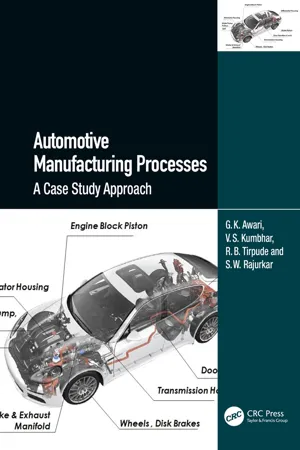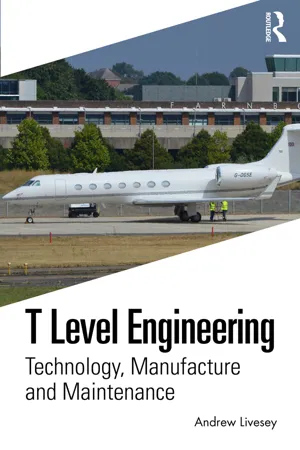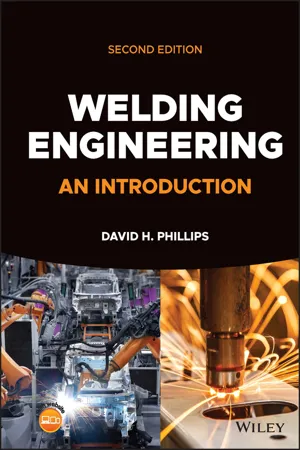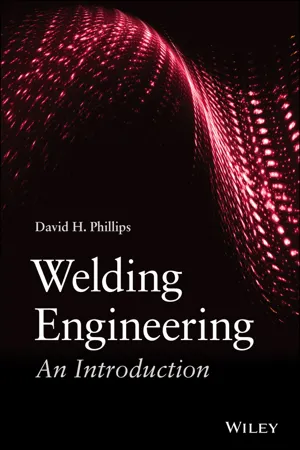Technology & Engineering
Non Ferrous Alloys
Non-ferrous alloys are metallic alloys that do not contain iron as a primary component. They are known for their desirable properties such as lightweight, corrosion resistance, and non-magnetic characteristics. Common non-ferrous alloys include aluminum, copper, titanium, and nickel-based alloys, which are widely used in various engineering applications due to their specific properties and performance advantages.
Written by Perlego with AI-assistance
Related key terms
Related key terms
1 of 4
Related key terms
1 of 3
4 Key excerpts on "Non Ferrous Alloys"
- eBook - ePub
Automotive Manufacturing Processes
A Case Study Approach
- G.K. Awari, V.S. Kumbhar, R.B. Tirpude, S.W. Rajurkar(Authors)
- 2023(Publication Date)
- CRC Press(Publisher)
2 Nonferrous MaterialsDOI: 10.1201/9781003367321-2Learning Objectives
- To understand the details of conventional and modern non ferrous materials their distinctive features and their vehicular applications.
- To cite distinctive physical and mechanical characteristics of nonferrous alloys.
- To understand the details of material decision making process
- To understand the business factors affecting material selection.
2.1 Introduction
Nonferrous metals are those which do not contain iron as the base material. The range of these nonferrous metals includes low-strength metals like aluminium and copper, and high-temperature resistant and high-strength alloys like titanium, molybdenum, etc. There are wider applications of nonferrous metals due to the following advantages:- Anticorrosive properties
- Good magnetic and electrical properties
- Ease of cold forming
- Fusibility and castability
- Lower density
- Attractive colour
- Good formability.
2.2 Nonferrous Materials and Their Alloys
Nonferrous metals are alloys or metals that do not contain any appreciable amounts of iron. All pure metals are nonferrous elements, except for iron (Fe), which is also called ferrite from the Latin “ferrum”, meaning “iron”. Nonferrous metals tend to be more expensive than ferrous metals but are used for their desirable properties, including light weight (aluminium), high conductivity (copper), and nonmagnetic properties or resistance to corrosion (zinc). Some nonferrous materials are used in the iron and steel industries, such as bauxite, which is used for flux in blast furnaces. Other nonferrous metals, including chromite, pyrolusite and wolframite, are used to make ferrous alloys. However, many nonferrous metals have low melting points, making them less suitable for applications at high temperatures. The details of copper, aluminium, lead, zinc, tin and nickel are presented in the following section. - eBook - ePub
T Level Engineering
Technology, Manufacture and Maintenance
- Andrew Livesey(Author)
- 2023(Publication Date)
- Routledge(Publisher)
Chapter 8 Engineering MaterialsDOI: 10.1201/9781003284833-8Engineers tend to classify materials into two major groups, each with two sub-groups. The major groups are metallic materials and non-metallic materials. We’ll look at each in turn (Table 8.1 ).Table 8.1Metallic Materials and Non-Metallic MaterialsEngineering Materials Metallic MaterialsFerrous – contains iron Non-ferrous – does not contain iron Iron in various forms Aluminium Low-carbon steel Brass – copper and zinc Medium-carbon steel Bronze – copper and tin High-carbon steel Chromium Alloy steel Copper Titanium Non-Metallic MaterialsNatural – occur in nature Synthetic – man-made materials Leather Carbon fibre Wood GRP – glass fibre Wool Vegan leather Bamboo Thermo-plastics Cotton cloth Thermo-setting plastics Metallic Materials
The metallic group is divided into two sub-groups, these are ferrous metals and non-ferrous metals. Ferrous simply means iron, all ferrous metals contain iron. Non-ferrous metals do not contain iron.Iron is dug from the ground and heated in a furnace – there are several different types of furnaces – and mixed with carbon to form steel. Steel has been used for engineering and construction since about 500 BC. When we talk about steel it is important to realise that there are several major categories of steel: low-carbon, medium-carbon, high-carbon and many types of alloy steel. When we talk about alloy steel, we simply mean that it is steel mixed with another element.Tech note
Ferrous – contains iron.Alloy – a mixture of a metal and another element.Manufacture of Steel
Iron ore which is dug up from the ground is fed into a blast furnace together with limestone and coke. The coke is used as a source of heat and the limestone as a flux, that is an agent which cleans and helps the flow of the metal. It separates the metal from the impurities in the mixture. The molten metal is then poured out of the furnace into moulds to form what are called pigs – chunks of iron which resemble the shape of a pig’s body. Because of the burning process the pig iron contains between 3–4% carbon. - eBook - ePub
Welding Engineering
An Introduction
- David H. Phillips(Author)
- 2023(Publication Date)
- Wiley(Publisher)
12 Welding Metallurgy of Nonferrous Alloys 12.1 Aluminum Alloys Aluminum alloys represent a family of widely used engineering materials in applications that usually require a combination of low density (light weight) and corrosion resistance. The corrosion resistance of these alloys results from the rapid formation of an aluminum oxide (Al 2 O 3) on the surface which is relatively stable at ambient temperatures. Because of this beneficial characteristic, applications involving aluminum often do not require protective paint or coatings. Unlike steels, they do not exhibit a ductile‐to‐brittle transition at low temperatures. The use of aluminum has increased markedly since the early 1990s. Most alloys are easily rolled, extruded, and drawn, and can be fabricated into a variety of shapes. With the recent thrust toward more lightweight electric and fuel-efficient and vehicles, the increase in potential aluminum applications in the automotive industry means the need to weld these alloys will continue to grow. Eight classes of wrought aluminum alloys have been defined by the Aluminum Association (Table 12.1). Individual alloys are designated using a four-digit number, with the first digit representing the basic class. The classes are distinguished by the primary alloying element(s) and how they are strengthened—either by cold work (strain hardening) or a precipitation-strengthening heat treatment. Other digits in the designation have no special significance. As the table shows, the 1xxx, 3xxx, 4xxx, and 5xxx alloys are all strengthened by cold work, whereas the 2xxx, 6xxx, 7xxx, and 8xxx alloys are all strengthened by a precipitation heat treatment. It is important to recognize the strengthening method for the alloy prior to welding - No longer available |Learn more
Welding Engineering
An Introduction
- David H. Phillips(Author)
- 2015(Publication Date)
- Wiley(Publisher)
12 Welding Metallurgy of Nonferrous Alloys 12.1 Aluminum Alloys Aluminum alloys represent a family of widely used engineering materials in applications that usually require a combination of low density (light weight) and corrosion resistance. The corrosion resistance of these alloys results from the rapid formation of an aluminum oxide (Al 2 O 3) on the surface, which is relatively stable at ambient temperatures. Because of this beneficial characteristic of the oxide, applications involving aluminum typically do not require protective paint or coatings. The use of aluminum has increased markedly since the early 1990s. Most alloys are easily rolled, extruded, and drawn, and can be fabricated into a variety of shapes. With the recent thrust toward more lightweight fuel-efficient vehicles, the potential for the widespread use of aluminum alloys in the automotive industry has sparked renewed interest in welding them. Unlike steels, they do not exhibit a ductile-to-brittle transition at low temperatures. Eight classes of wrought aluminum alloys have been defined by the Aluminum Association (Table 12.1). Individual alloys are designated using a four-digit number, with the first digit representing the basic class. These classes are distinguished by the primary alloying element(s) and how they are strengthened—either by cold work (strain hardening) or a precipitation-strengthening heat treatment. Other digits in the designation have no special significance. As the table shows, the 1xxx, 3xxx, 4xxx, and 5xxx alloys are all strengthened by cold work, whereas the 2xxx, 6xxx, 7xxx, and 8xxx alloys are all strengthened by a precipitation heat treatment. It is important to recognize the strengthening method for the alloy prior to welding
Index pages curate the most relevant extracts from our library of academic textbooks. They’ve been created using an in-house natural language model (NLM), each adding context and meaning to key research topics.
Explore more topic indexes
Explore more topic indexes
1 of 6
Explore more topic indexes
1 of 4



